An Experimental and Analytical Study on the Deflection Behavior of Precast Concrete Beams with Joints
Abstract
:1. Introduction
2. Experimental Program
2.1. Materials and Methods
2.2. Loading Test Setup
2.3. Loading Test Result
2.4. Estimation of Deflection
2.5. Test Cases
3. Results and Discussion
4. Conclusions
- To estimate the deflection of the modular specimen, the equation given by Branson was used. It was found that the deflection underestimated the experimental results by a difference of 2.41 mm.
- Detailed deflection estimations were performed for four cases that took into account the effects of the initial cracks at the joint and the modulus of elasticity. In addition, the attached transmission length () of the steel reinforcement and concrete on the crack surface at the joint was considered as a new crack area. The deflection values of Cases 1, 3, and 4 were underestimated as ratios of 0.74, 0.32, and 0.78, respectively. However, the value for Case 2 was overestimated to be 1.21 before the application of the cracking moment. Following the application of the cracking moment, the values for all cases were overestimated as average ratios of 1.4, 1.55, 1.04, and 1.19, respectively.
- Case 4 had an error rate of 19.5%, which was the most accurate prediction. This case demonstrates the effectiveness of estimating modular slabs with joints to reflect the attached transmission length (length of lapped splices) to the left and right sides of the joint and considering non-cracking section for UHSC of joint until fail the specimen.
- This study considered the difference in strength between precast concrete modules, the UHSC of the joint, and the attached transmission length to induce tension-stiffening for a new crack area. There are similar methods for evaluating deflection, such as weighted EI; however, engineers change the detailed calculation process based on their experiences such that consistent predictions are difficult to make. Therefore, dividing a section of precast concrete beam with joints can be an effective and structured prediction method.
Acknowledgments
Author Contributions
Conflicts of Interest
References
- Culmo, M.P. Accelerated Bridge Construction-Experience in Design, Fabrication and Erection of Prefabricated Bridge Elements and Systems; FHWA-HIF-12-013; Federal Highway Administration: Salem, OR, USA, 2011; pp. 52–270.
- Choi, J.; Park, S.K.; Kim, H.Y.; Hong, S. Behavior of high-performance mortar and concrete connections in precast concrete elements: Experimental investigation under static and cyclic loadings. Eng. Struct. 2015, 100, 633–644. [Google Scholar] [CrossRef]
- Li, L.; Jiang, Z. Flexural Behavior and Strut-and-tie Model of Joints with headed bar details Connecting Precast Members. Perspect. Sci. 2016, 7, 253–260. [Google Scholar] [CrossRef]
- Ryu, H.K.; Kim, Y.J.; Chang, S.P. Experimental study on static and fatigue strength of loop joints. Eng. Struct. 2007, 29, 145–162. [Google Scholar] [CrossRef]
- Buyukozturk, O.; Bakhoum, M.M.; Beattie, S.M. Shear Behavior of Joints in Precast Concrete Segmental Bridges. J. Struct. Eng. 1990, 116, 3380–3401. [Google Scholar] [CrossRef]
- Saibabu, S.; Srinivas, V.; Sasmal, S.; Lakshmanan, N.; Iyer, N.R. Performance evaluation of dry and epoxy jointed segmental prestressed box girders under monotonic and cyclic loading. Constr. Build Mater. 2013, 38, 931–940. [Google Scholar] [CrossRef]
- Issa, M.A.; Abdalla, H.A. Structural Behavior of Single Key Joints in Precast Concrete Segmental Bridges. J. Bridge Eng. 2007, 12, 315–324. [Google Scholar] [CrossRef]
- Graybeal, B.A. Behavior of Ultra-High Performance Concrete Connections between Precast Bridge Deck Elements. In Proceedings of the 2010 Concrete Bridge Conference: Achieving Safe, Smart & Sustainable Bridges, Phoenix, AZ, USA, 24 February 2010. [Google Scholar]
- Li, L.; Ma, Z.; Griffey, M.E.; Oesterle, R.G. Improved Longitudinal Joint Details in Decked Bulb Tees for Accelerated Bridge Construction: Concept Development. J. Bridge Eng. 2010, 15, 327–336. [Google Scholar] [CrossRef]
- Chapman, C.E. Behavior of Precast Bridge Deck Joints with Small Bend Diameter U-Bars. Master’s Thesis, University of Tennessee, Knoxville, TN, USA, 2010. [Google Scholar]
- Shah, B.N.; Sennah, K.; Kianoush, M.R.; Tu, S.; Lam, C. Experimental Study on Prefabricated Concrete Bridge Girder-to-Girder Intermittent Bolted Connections System. J. Bridge Eng. 2007, 12, 570–584. [Google Scholar] [CrossRef]
- Zhu, P.; Ma, Z.Z.; Cao, Q.; French, C.C. Fatigue Evaluation of Transverse U-Bar Joint Details for Accelerated Bridge Construction. J. Bridge Eng. 2012, 17, 191–200. [Google Scholar] [CrossRef]
- Grace, N.; Ushijima, K.; Baah, P.; Bebawy, M. Flexural Behavior of a Carbon Fiber-Reinforced Polymer Prestressed Decked Bulb T-Beam Bridge System. J. Compos. Constr. 2013, 17, 497–506. [Google Scholar] [CrossRef]
- Park, J.; Choi, J.; Lee, H.M.; Park, S.K.; Hong, S. Evaluation of Structural Behavior and Moment of Inertia on Modular Slabs Subjected to Cyclic Loading. J. Korea Inst. Struct. Maint. Insp. 2015, 19, 95–102. [Google Scholar] [CrossRef]
- Pohang Iron and Steel Company. Research & Business Development of Modular Bridges, Final ed.; Korea Agency for Infrastructure Technology Advancement: Anyang, Korea, 2015; pp. 1–160. [Google Scholar]
- American Association of State Highway and Transportation Officials. AASHTO LRFD Bridge Design Specification, 5th ed.; American Association of State Highway and Transportation Officials: Washington, DC, USA, 2010. [Google Scholar]
- Ministry of Land, Transport and Maritime Affairs. Bridge Design Code 2010, 1st ed.; Korea Road Association: Seoul, Korea, 2010.
- Korea Concrete Institute. Concrete Structures Design Code, 1st ed.; Korea Concrete Institute: Seoul, Korea, 2012. [Google Scholar]
- Gilbert, R.I.; Warner, R.F. Tension Stiffening in Reinforced Concrete Slabs. J. Struct. Div. 1978, 104, 1885–1900. [Google Scholar] [CrossRef]
- Floegl, H.; Mang, H.A. Tension stiffening Concept based on Bond Slip. J. Struct. Div. 1982, 108, 2681–2701. [Google Scholar]
- Visintin, P.; Sturm, A.B.; Oehlers, D.J. Long- and Short-term Serviceability Behavior of Reinforced Concrete Beams: Mechanics models for deflections and crack width. Struct. Concr. 2017, 18, 1–19. [Google Scholar] [CrossRef]
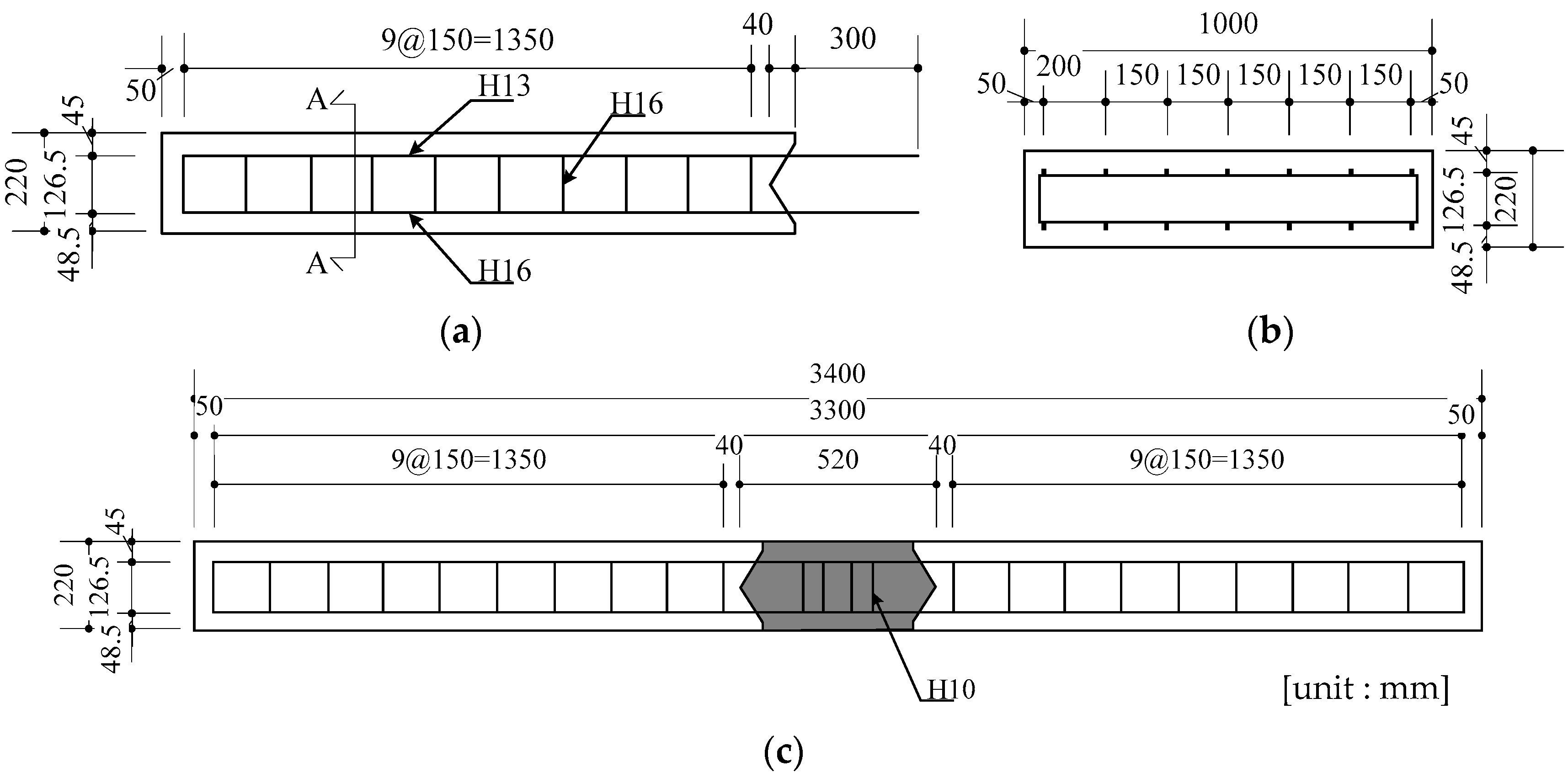



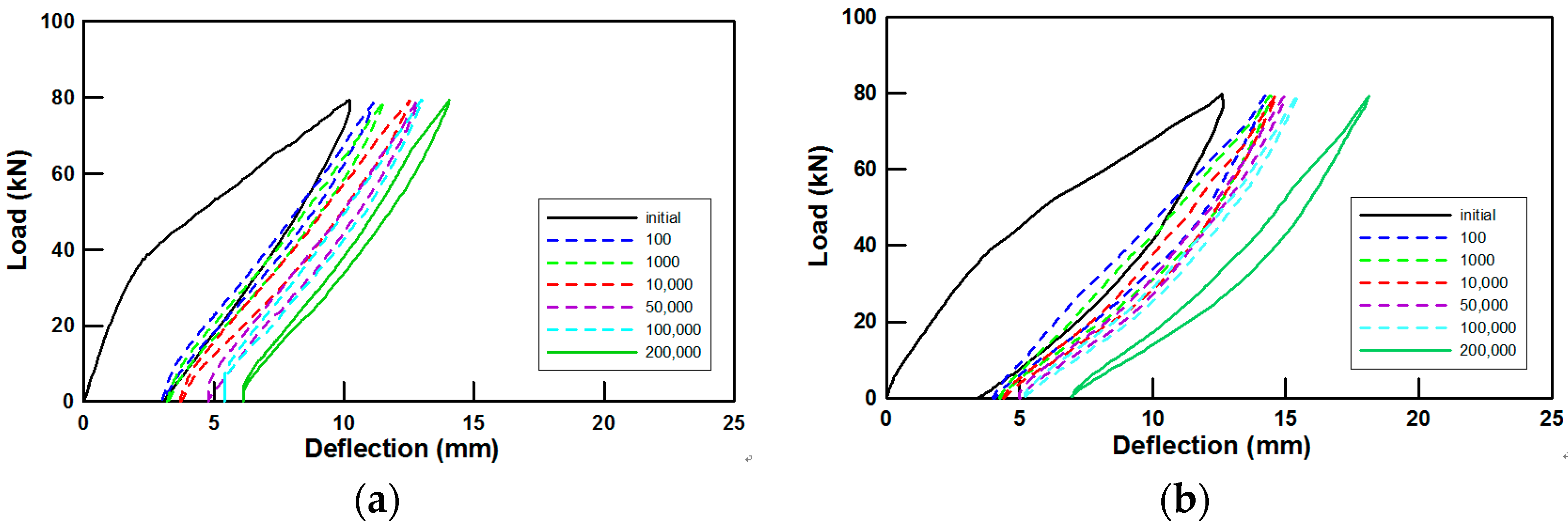
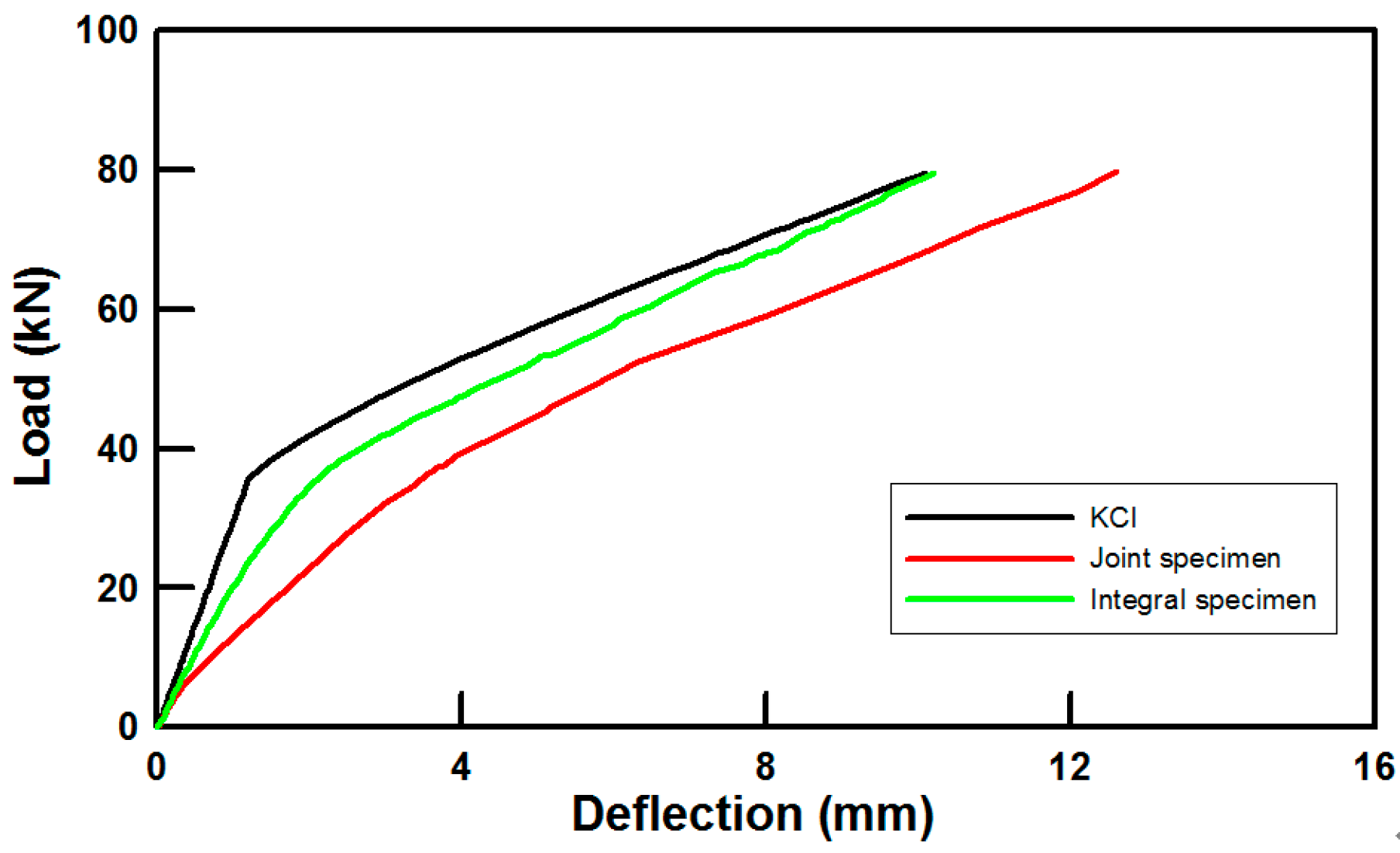
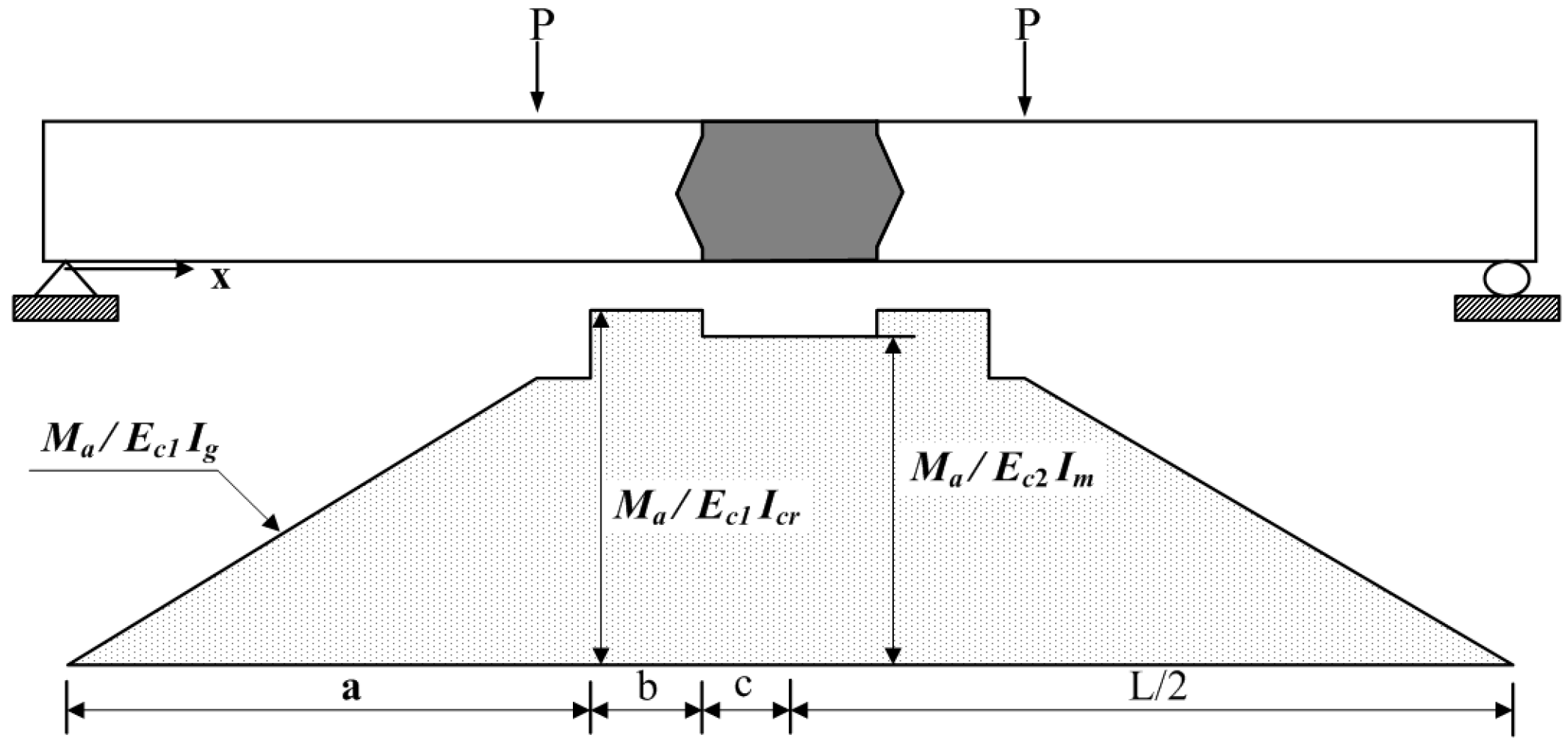
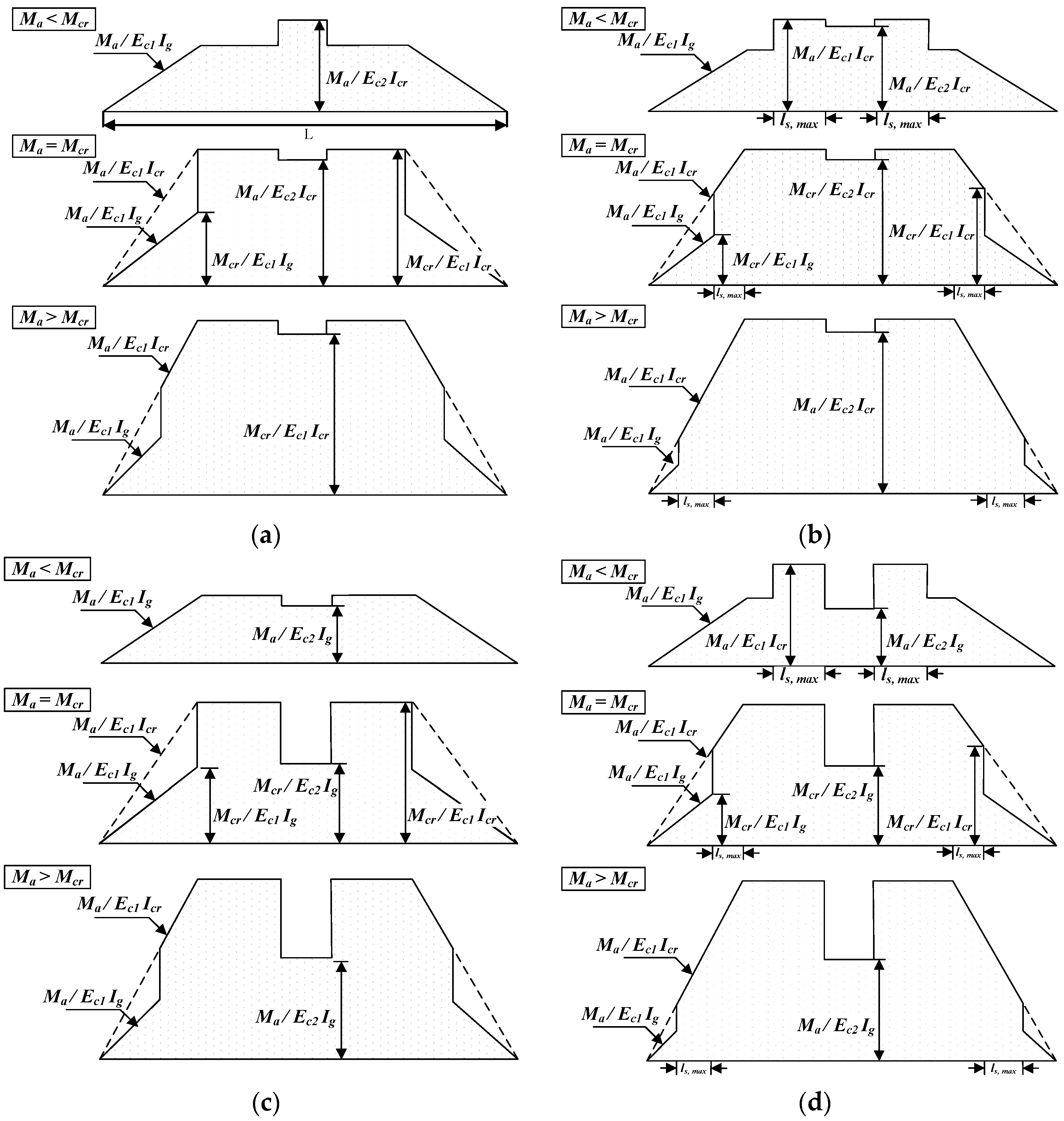
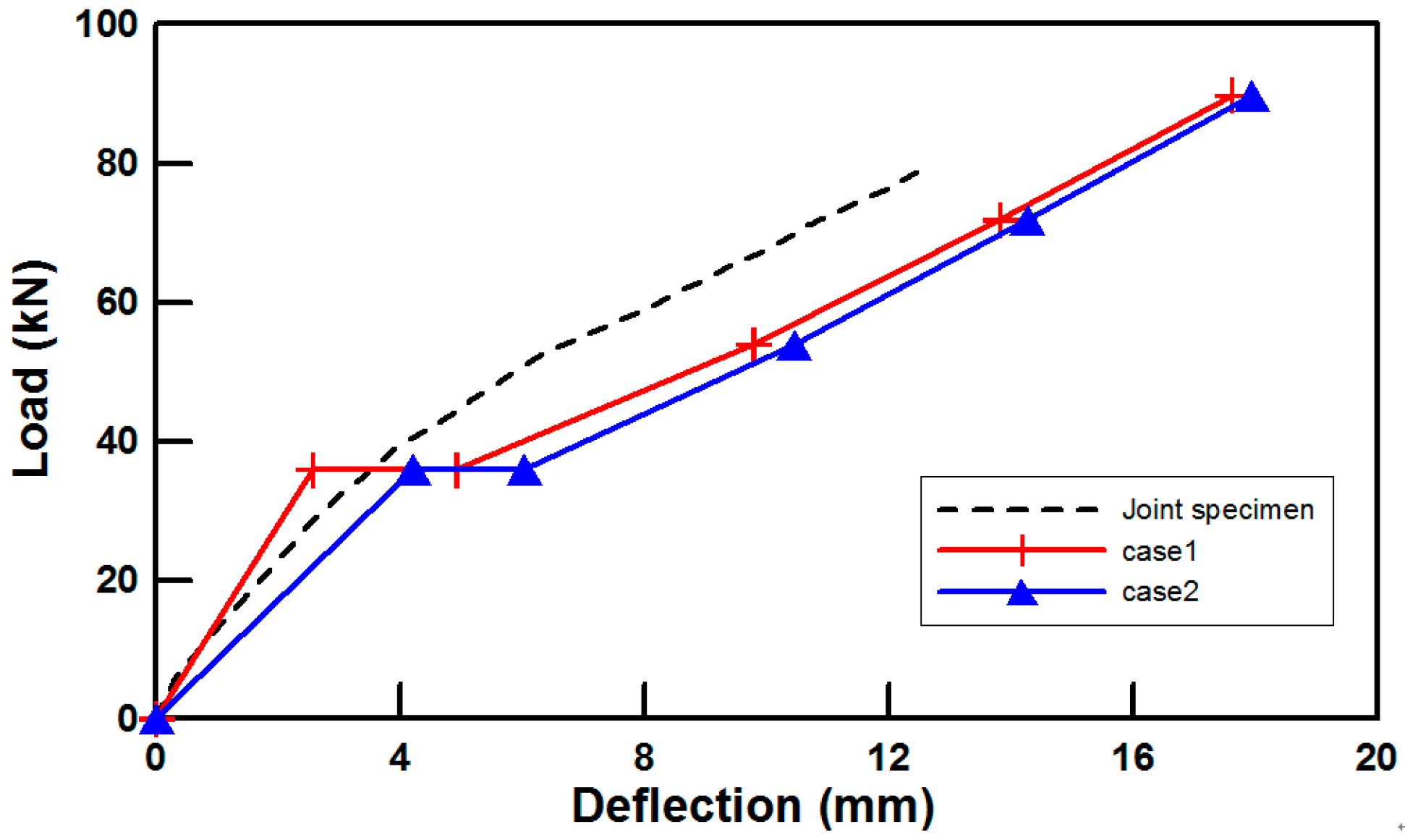
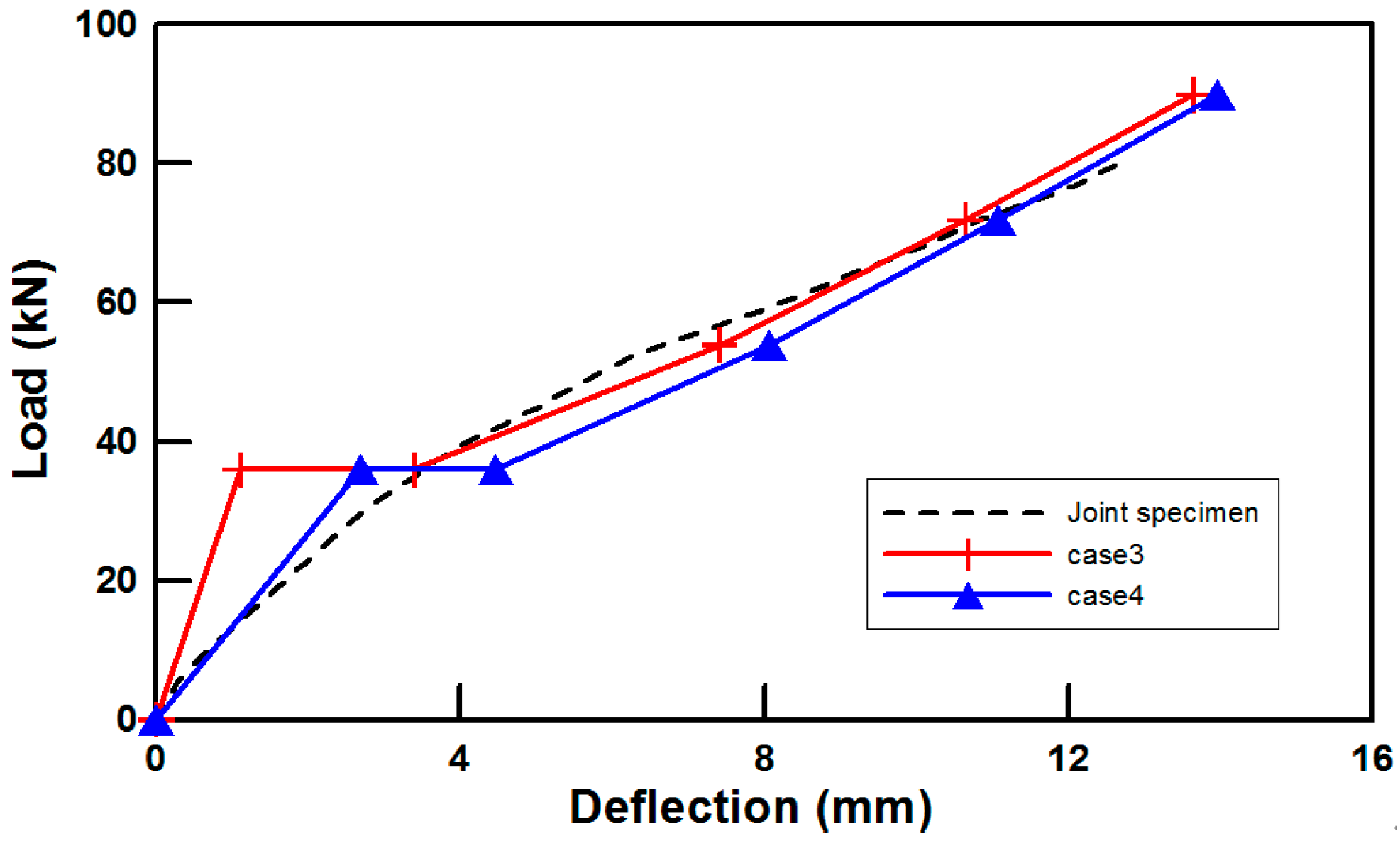
| Cycle Number | Deflection at Center (mm) | |
|---|---|---|
| Integral | Modular | |
| Initial | 10.21 | 12.62 |
| 100 | 11.14 | 14.25 |
| 1000 | 11.59 | 14.43 |
| 10,000 | 13.00 | 14.62 |
| 50,000 | 13.96 | 14.96 |
| 100,000 | 15.45 | 15.47 |
| 200,000 | 16.19 | 18.12 |
| Coefficient | |||
|---|---|---|---|
| Value | 887.33 | 141.29 | 35.9 |
| Specimen | Attached Transmission Length () | Moment of Inertia at Connection |
|---|---|---|
| Case 1 | - | cracked section |
| Case 2 | 200 mm | |
| Case 3 | - | gross concrete section |
| Case 4 | 200 mm |
| Load | Modular | Case 1 | Case 2 | Case 3 | Case 4 | ||||
|---|---|---|---|---|---|---|---|---|---|
| mm | Ratio | mm | Ratio | mm | Ratio | mm | Ratio | ||
| 3.47 | 2.57 | 0.74 | 4.21 | 1.21 | 1.12 | 0.32 | 2.7 | 0.78 | |
| 3.56 | 4.92 | 1.38 | 6.04 | 1.7 | 3.40 | 0.96 | 4.47 | 1.26 | |
| 6.32 | 9.79 | 1.55 | 10.45 | 1.65 | 7.41 | 1.17 | 8.06 | 1.28 | |
| 10.86 | 13.83 | 1.27 | 14.27 | 1.31 | 10.64 | 0.98 | 11.07 | 1.02 | |
| - | 17.63 | - | 17.95 | - | 13.64 | - | 13.95 | - | |
| Avg. error | - | 0.365 | 0.4675 | 0.2275 | 0.195 | ||||
© 2017 by the authors. Licensee MDPI, Basel, Switzerland. This article is an open access article distributed under the terms and conditions of the Creative Commons Attribution (CC BY) license (http://creativecommons.org/licenses/by/4.0/).
Share and Cite
Park, J.; Choi, J.; Jang, Y.; Park, S.-K.; Hong, S. An Experimental and Analytical Study on the Deflection Behavior of Precast Concrete Beams with Joints. Appl. Sci. 2017, 7, 1198. https://doi.org/10.3390/app7111198
Park J, Choi J, Jang Y, Park S-K, Hong S. An Experimental and Analytical Study on the Deflection Behavior of Precast Concrete Beams with Joints. Applied Sciences. 2017; 7(11):1198. https://doi.org/10.3390/app7111198
Chicago/Turabian StylePark, Jongho, Jinwoong Choi, Yongjoon Jang, Sun-Kyu Park, and Sungnam Hong. 2017. "An Experimental and Analytical Study on the Deflection Behavior of Precast Concrete Beams with Joints" Applied Sciences 7, no. 11: 1198. https://doi.org/10.3390/app7111198




